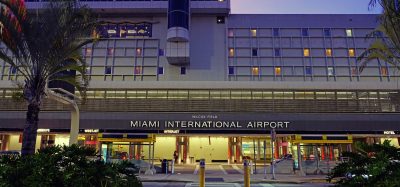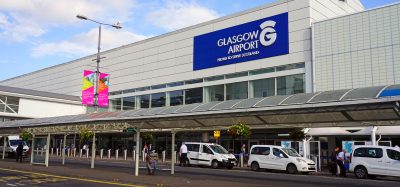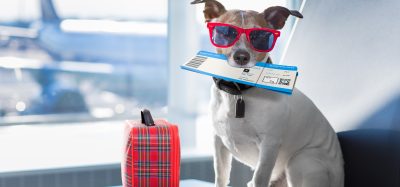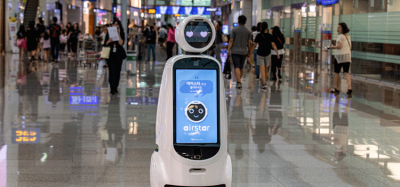Taking flight: Experiencing air travel with reduced mobility
- Like
- Digg
- Del
- Tumblr
- VKontakte
- Buffer
- Love This
- Odnoklassniki
- Meneame
- Blogger
- Amazon
- Yahoo Mail
- Gmail
- AOL
- Newsvine
- HackerNews
- Evernote
- MySpace
- Mail.ru
- Viadeo
- Line
- Comments
- Yummly
- SMS
- Viber
- Telegram
- Subscribe
- Skype
- Facebook Messenger
- Kakao
- LiveJournal
- Yammer
- Edgar
- Fintel
- Mix
- Instapaper
- Copy Link
Posted: 19 February 2018 | Mik Scarlet | Journalist and Campaigner | No comments yet
In this article, TV presenter, journalist and disability rights campaigner Mik Scarlet talks about his experiences flying as a passenger with reduced mobility.
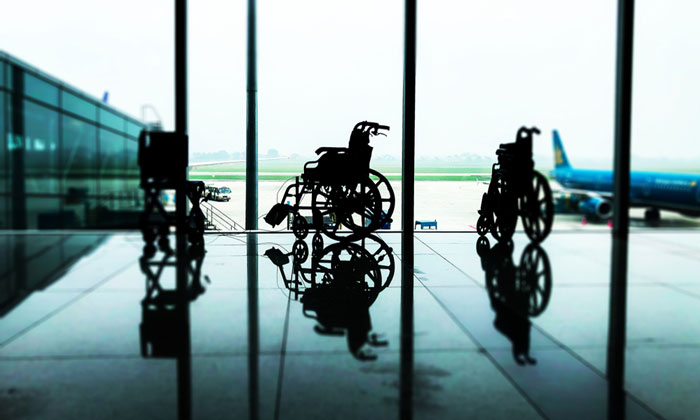

INTERNATIONAL: Mik's career has seen him travel extensively
I have been disabled since birth. I was born with a rare form of cancer, called an adrenal neuroblastoma, and while it was successfully treated I was left with a weakened right leg. As a child I suppose the airline industry would have called me an ambulatory person of reduced mobility. This meant I grew up pretty much like everyone else. I went to a mainstream school and, other than being rubbish at most sports and needing a tricycle rather than a bicycle, my childhood was pretty conventional. I only flew once as a walker, when I was eight and I remember it being an exciting fun experience. Then, when I was fifteen, a side effect of my cancer treatment caused my spine to collapse and suddenly I lost the ability to walk at all, becoming a full time wheelchair user.
I found that the element of being a wheelchair user that takes the most getting used to was always requiring extra help to do things. It took some time to reassert my independence, learning new ways to do even the simplest things, but once I had I still found that some parts of life were impossible for me to achieve without asking for help. This needing help was the most annoying part of being a wheelchair user, and I still find it so over thirty seven years later. It became especially frustrating when I discovered the Social Model of Disability.
In a nutshell, the Social Model of Disability states that while I have physical differences, in that I cannot walk as I have a spinal injury, that is not what disables me.
For the early years of being a wheelchair user, and throughout my childhood, I understood that I was disabled by what I couldn’t do, by what was physically different about me. Everyone I met, especially the medical professionals, described my “disability” through a lens of what didn’t work right and what they were continuously trying to fix.
Then one day I met a disability rights activist called Vicky Waddington, who changed me life. By this time I had broken into the world of the media and was a well known TV presenter and broadcaster. Vicky could see that while I had a high profile I was not very politically aware about disability, and she took on herself to change this. She trapped me in a lift at the ITV offices that were then just off the Euston Road in London, and as the lift went up and down this amazing woman changed my life for ever.
In a nutshell, the Social Model of Disability states that while I have physical differences, in that I cannot walk as I have a spinal injury, that is not what disables me. It says that this difference is my “impairment” but my disability is placed on me by the world around me, either through physical barriers or by society’s attitudes towards me. If you imagine in a world that didn’t see requiring a wheelchair as something tragic or awful but instead admitted it was just a different way of getting around, and that was designed so I could be as independent as possible with any extra help I might require being seen as usual then would I still be “disabled”? I’d be different, but then I think we can agree that we are all different, so why should requiring a wheelchair to get around be any different to the size of shoe you wear? The Social Model is a wonderful way of understanding disability as it allows for us to strive to build a world where impairment does equal lack of ability, where difference is celebrated and our world is modified to be inclusive for all peoples.
All of this is great, but how does it apply to an article about my experiences of airports and flying? Well, let me explain using a few of my flying “highlights”. My first trip on a plane following becoming a wheelchair user was when I was twenty one. My best mate and I flew off to Ibiza, back before it became the rave capital of the world and was instead a hippy alternative haven, and had booked through a package holiday company. We flew from an airport that required steps up to the plane, meaning I had to be carried up in a carry on chair. Once I had been strapped in, I waved goodbye to my wheelchair being told I would get it back at baggage claim in Ibiza. I was then carried up the the stairs but rather than being lifted up head first, the ground crew carried me up feet first, with my head firmly pushed into the groin of one of those lifting me.
Obviously they had made a mistake, and this was compounded when they had no idea how to to put me down once in the plane, so they dropped me. This hurt, but I swallowed the pain and my pride as I had no idea that this was not the standard method for getting wheelchair users on to flights. The flight went fine, thanks to a few beers but on arrival things really came off the rails. It took an age to get taken off the plane, so much so that by the time we arrived at baggage reclaim the only things left on the carousel was our suitcases and my wheelchair. My obviously broken wheelchair. Even before I tried to sit in my chair everyone could see it had been snapped in two. Everyone “assisting” me claimed they could do nothing and I was left to battle my way into the coach before setting off to our hotel. I spent a week trapped in the hotel room while my best mate tried to find someone who could weld my chair together. After the second week, which was great fun I must admit, we prepared ourselves for out flight home. I was carried on to the plane with ease, but as I looked out of the window once seated I saw the baggage handlers jumping on my wheelchair trying to get it to fold. As it had been welded solid to repair the damage done on the outward journey this was impossible, so instead they snapped both my wheels. On landing back inn the UK, I struggled to a cab to take me home and spent another two weeks unable to go anywhere while I waited for a new wheelchair. Did the airport or airline offer help, or even an apology? No.
The saddest thing is that when I took my original flight in the 1980’s, flying was the most accessible means of getting around.
I have had four wheelchairs broken since then, each costing around three to five thousand pounds, and many more merely damaged in such a way that allowed me to repair them myself. I’ve been injured while being boarded and last year even broke my leg while on a flight to Vienna, due to the cabin crew’s obvious lack of training around assisting a passenger with reduced mobility. To think that flight was my last experience of flying, so both my first and my last ended in disaster. In fact if I was to list all of the disasters I’ve experienced when flying I would run out of space when I was less than half way through. On top of my own stories of woe, I’ve seen others have equally nightmarish times, so I know it’s not me. I’m not jinxed in some way. I’ve seen people manhandled on and off planes as if they were sacks of potatoes, not paying customers. The horror stories of broken wheelchairs and equipment I am sent whenever I mention another personal flying nightmare on social media are terrifying. Sometimes I’m amazed that anyone disabled takes to the air at all.
The saddest thing is that when I took my original flight in the 1980’s, flying was the most accessible means of getting around. Trains, buses, most underground systems and even taxis were pretty much closed to wheelchair users like me. Despite ending up with a broken chair and a bruised back, I came home from my holiday to Ibiza filled with confidence of what my future might hold. I now knew I could travel all over the world.
Shortly after this experience I landed a job on TV and I soon found myself travelling the world filming. I even did a stint presenting for the Holiday series. I did see improvement around access provision with airports, but compared to other forms of transport it was slow. Fast forward to today and in the UK I can get on pretty much all buses, most trains are accessible with assistance, all taxis are legally required to take wheelchair users with some being specially designed to take wheelchair users who cannot transfer out of their chairs and even some of London Underground is accessible. In many other countries I visit the public transport system’s access provision is even better. Much of the globe’s transport sector have adopted the Social Model and are applying it to how they develop going forward, with the aim of becoming more accessible and inclusive.
In the thirty plus years since my first flight the airline industry should have been able to match and easily surpass the advances of other modes of transport as nearly all of it’s infrastructure is much newer. Yet this isn’t the case. No one can deny that things have got much better, but these improvements are patchy. One airport can be superb, while another fails at every turn. You can even experience these differences on one flight, taking off with one extreme and landing with another. The solution? For the industry to develop an international standard, based on the expectations of people from those countries where disability rights are most developed. It is vital that disabled people are the key drivers of these improvements. We know how to improve the service and access provision so that it works for everyone. If every airport and airline adopts the Social Model and applies it to what they do, everyone wins in the long run. Disabled people make up one in five people on the planet, with a disposable income of nearly one trillion dollars that goes up just under seven trillion dollars if you include their friends and families, and so are a market ready to be tapped. More and more disabled people want to travel and if the air industry gets it right this huge market will make any moves towards becoming a more inclusive not only morally right but financially beneficial.
The other less obvious benefit? I will be able to stop writing such down beat articles and focus on something I truly adore, travel.



